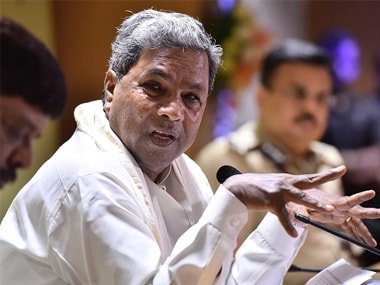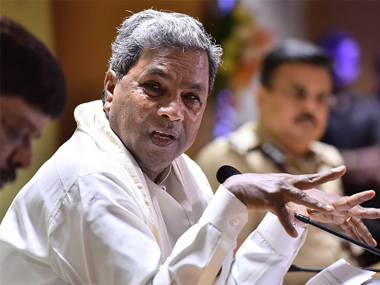If there was a political equivalent of playing with fire, Siddaramaiah’s decision to contest from the Chamundeshwari constituency comes close. He returns to his old constituency in Mysuru from where he has won five times and lost twice. The narrowest of those victories came in the 2006 by-election, when he won against the combined JD(S)-BJP candidate by a margin of 257 votes. After delimitation in 2004, parts of Chamundeshwari constituency were moved to Varuna. Siddaramaiah won the 2008 and 2013 elections from neighbouring Varuna. But with his desire to see his son, Yathindra take a plunge into electoral politics, Siddaramaiah has given up on his safe Varuna seat to risk it in Chamundeshwari. The odds are stacked against Siddaramaiah in this constituency that is named after the hilltop Goddess Chamundeshwari, the presiding deity of Mysuru. [caption id=“attachment_4423771” align=“alignleft” width=“380”] File image of Siddaramaiah. Getty Images[/caption] He will be up against GT Deve Gowda of the JD(S). Gowda is the sitting MLA and also a one-time close associate of the chief minister. Siddaramaiah wants to pitch his decision to contest from his erstwhile constituency as the return of the prodigal son in what is being spoken of as his 10th and final electoral battle. But Gowda labels Siddaramaiah as someone who “abandoned” Chamundeshwari for Varuna after his skip-a-heartbeat 2006 victory. There is a feeling that Siddaramaiah walked into a trap over Chamundeshwari. Former chief minister HD Kumaraswamy had dared him to contest from Chamundeshwari instead of choosing another safe seat in Mysuru. Determined to prove a point to his erstwhile party, Siddaramaiah accepted the challenge. With no love lost between Siddaramaiah, the JD(S) and the BJP, it is more than likely that there could be a tacit understanding between the two Opposition parties in Karnataka to ensure the chief minister’s defeat in Chamundeshwari. The BJP is not a strong player in this part of Karnataka and has never won from Chamundeshwari. Kumaraswamy has been trying to get under Siddaramaiah’s skin by claiming that intelligence reports have predicted the chief minister will lose. It is very obvious that while GT Deve Gowda is the candidate, Siddaramaiah’s real fight is with his namesake, HD Deve Gowda and family. It is also very personal because in 2006 when Siddaramaiah won the bypoll, Kumaraswamy was Karnataka’s chief minister, heading the JD(S)-BJP coalition government. Kumaraswamy campaigned hard to ensure Siddaramaiah’s defeat because the result was to be seen as a comment on who people thought the real political successor of HD Deve Gowda was. Another Siddaramaiah-baiter Srinivas Prasad, who was revenue minister in the Congress cabinet before being unceremoniously dumped two years ago, will also like to see the chief minister lose. The senior Dalit leader has a score to settle as Siddaramaiah went out of his way to ensure his defeat in the Nanjungud bypoll in Mysuru district in 2017. Prasad had contested from Nanjungud as a BJP candidate after exiting the Congress. The caste matrix makes it a tough contest. The 2.5 lakh voters are dominated by over 70,000 Vokkaligas (Gowda’s community) and OBCs (Siddaramaiah is a Kuruba, an OBC community), who along with Dalits and Muslims number close to 1.2 lakh. Lingayats count for about 30,000 and Siddaramaiah would hope his government’s decision on according them separate religion status will work to his advantage. There is an interesting bit of history here. In 2004, the BSP contested from Chamundeshwari, polling 9700 votes. Fortunately for Siddaramaiah, the party did not contest the bypoll two years later. Which is why the BSP is seen as having played a part in Siddaramaiah’s rebirth in politics. But for that 257 vote victory, Siddaramaiah would have been pushed into political oblivion. Now with BSP’s electoral alliance with the JD(S), the Dalit vote could prove to be the deciding factor.
File image of Siddaramaiah. Getty Images[/caption] He will be up against GT Deve Gowda of the JD(S). Gowda is the sitting MLA and also a one-time close associate of the chief minister. Siddaramaiah wants to pitch his decision to contest from his erstwhile constituency as the return of the prodigal son in what is being spoken of as his 10th and final electoral battle. But Gowda labels Siddaramaiah as someone who “abandoned” Chamundeshwari for Varuna after his skip-a-heartbeat 2006 victory. There is a feeling that Siddaramaiah walked into a trap over Chamundeshwari. Former chief minister HD Kumaraswamy had dared him to contest from Chamundeshwari instead of choosing another safe seat in Mysuru. Determined to prove a point to his erstwhile party, Siddaramaiah accepted the challenge. With no love lost between Siddaramaiah, the JD(S) and the BJP, it is more than likely that there could be a tacit understanding between the two Opposition parties in Karnataka to ensure the chief minister’s defeat in Chamundeshwari. The BJP is not a strong player in this part of Karnataka and has never won from Chamundeshwari. Kumaraswamy has been trying to get under Siddaramaiah’s skin by claiming that intelligence reports have predicted the chief minister will lose. It is very obvious that while GT Deve Gowda is the candidate, Siddaramaiah’s real fight is with his namesake, HD Deve Gowda and family. It is also very personal because in 2006 when Siddaramaiah won the bypoll, Kumaraswamy was Karnataka’s chief minister, heading the JD(S)-BJP coalition government. Kumaraswamy campaigned hard to ensure Siddaramaiah’s defeat because the result was to be seen as a comment on who people thought the real political successor of HD Deve Gowda was. Another Siddaramaiah-baiter Srinivas Prasad, who was revenue minister in the Congress cabinet before being unceremoniously dumped two years ago, will also like to see the chief minister lose. The senior Dalit leader has a score to settle as Siddaramaiah went out of his way to ensure his defeat in the Nanjungud bypoll in Mysuru district in 2017. Prasad had contested from Nanjungud as a BJP candidate after exiting the Congress. The caste matrix makes it a tough contest. The 2.5 lakh voters are dominated by over 70,000 Vokkaligas (Gowda’s community) and OBCs (Siddaramaiah is a Kuruba, an OBC community), who along with Dalits and Muslims number close to 1.2 lakh. Lingayats count for about 30,000 and Siddaramaiah would hope his government’s decision on according them separate religion status will work to his advantage. There is an interesting bit of history here. In 2004, the BSP contested from Chamundeshwari, polling 9700 votes. Fortunately for Siddaramaiah, the party did not contest the bypoll two years later. Which is why the BSP is seen as having played a part in Siddaramaiah’s rebirth in politics. But for that 257 vote victory, Siddaramaiah would have been pushed into political oblivion. Now with BSP’s electoral alliance with the JD(S), the Dalit vote could prove to be the deciding factor.
But then, the Siddaramaiah of 2018 is a far cry from the Siddaramaiah of 2006.
At that time, he had made his exit from JD(S) and was looking to carve space for himself in the top-heavy Congress. Now he returns to Chamundeshwari as chief minister and voters will look for benefits that may accrue from being his constituency. The argument is that caste dynamics may matter little when the choice is between electing Siddaramaiah who will be chief minister if Congress returns to power or GT Deve Gowda, who will be just another MLA. Siddaramaiah’s visits to woo voters have met with mixed results. BJP leaders have been reporting with glee about poor attendance at his meetings in Chamundeshwari. But that is not bothering the Congress camp as Siddaramaiah in his trademark rustic manner, is also reaching out to people he knows personally in this semi-urban constituency. A hitch for Siddaramaiah will be that as the party’s star campaigner, he will have to focus on all 30 districts in Karnataka, leaving little time for Chamundeshwari and Varuna. Yathindra will need Siddaramaiah’s help as the BJP has upped the stakes in Varuna with BS Yeddyurappa’s son, Vijayendra likely to be the party candidate.
)